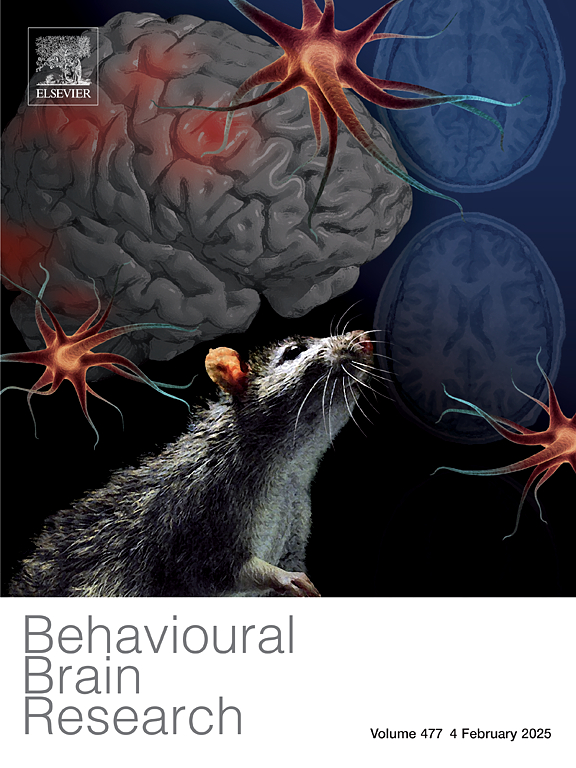用cTBS破坏害怕蜘蛛个体的恐惧记忆再巩固:一项概念验证研究。
IF 2.3
3区 心理学
Q2 BEHAVIORAL SCIENCES
引用次数: 0
摘要
认知行为疗法和精神药理学干预均可有效治疗焦虑症。然而,只有50%的患者表现出从这些方法中显著获益。因此,研究提高治疗效果的策略或开发新的治疗方法仍然是一个重要的研究目标。目前的治疗方式可能会使最初的恐惧记忆保持完整,随着时间的推移可能导致症状复发。相反,再巩固过程的中断可以促进对恐惧记忆的永久性修改,从而降低心理治疗后复发的风险。最近的实验室研究表明,重复性经颅磁刺激(rTMS)可以有效地破坏实验诱发的恐惧的再巩固,并显著防止恐惧的复发。在这项研究中,我们将这些结果转化为对蜘蛛有高度恐惧的参与者。34名有蜘蛛恐惧的参与者被随机分配到verum或安慰剂干预组,在蜘蛛恐惧记忆重新激活(与活狼蛛对峙3分钟)10分钟后,使用连续的θ -burst刺激(静息运动阈值的80%)在右背外侧前额叶皮层施加。主要结局(蜘蛛恐惧症问卷,SPQ)的方差分析显示时间对治疗有显著影响,但时间与治疗组无显著交互作用。值得注意的是,探索性分析揭示了verum组的刺激强度与蜘蛛恐惧减少之间的显著相关性。这种关联表明,rtms诱导的再巩固中断可能是焦虑症的一种可行的治疗选择;然而,需要进一步的研究来确定这些干预措施的最佳参数。本文章由计算机程序翻译,如有差异,请以英文原文为准。
Disrupting fear memory reconsolidation in individuals with fear of spiders with cTBS: A Proof-of-Concept Study
Anxiety disorders can be effectively treated with both cognitive behavioural therapy and psychopharmacological interventions. However, only 50 % of patients demonstrate significant benefits from these approaches. Therefore, investigating strategies to improve treatment effectiveness or develop novel therapeutic approaches remains an important research objective. Current therapeutic modalities may leave the original fear memory intact, potentially leading to symptom recurrence over time. In contrast, the disruption of reconsolidation processes can facilitate permanent modifications to fear memory, resulting in a reduced risk of relapse after psychotherapy. Recent laboratory studies have shown that the reconsolidation of experimentally induced fear can be effectively disrupted by repetitive transcranial magnetic stimulation (rTMS) and significantly prevents the return of fear. In this study, we translated these results to participants with elevated fear of spiders. 34 participants with spider fear were randomly assigned to a verum or a placebo intervention using continuous theta-burst stimulation (80 % of resting motor threshold) applied over the right dorsolateral prefrontal cortex ten minutes after the reactivation (3 min confrontation with a living tarantula) of the spider fear memory. The ANOVA for the primary outcome (Spider Phobia Questionnaire, SPQ) resulted in a significant effect of time, but no significant interaction of time and treatment group. Notably, exploratory analyses revealed a significant correlation between stimulation intensity in the verum group and the reduction in spider fear. This association suggest that rTMS-induced disruptions of reconsolidation may serve as a viable therapeutic option for anxiety disorders; however, further research is needed to delineate the optimal parameters for such interventions.
求助全文
通过发布文献求助,成功后即可免费获取论文全文。
去求助
来源期刊

Behavioural Brain Research
医学-行为科学
CiteScore
5.60
自引率
0.00%
发文量
383
审稿时长
61 days
期刊介绍:
Behavioural Brain Research is an international, interdisciplinary journal dedicated to the publication of articles in the field of behavioural neuroscience, broadly defined. Contributions from the entire range of disciplines that comprise the neurosciences, behavioural sciences or cognitive sciences are appropriate, as long as the goal is to delineate the neural mechanisms underlying behaviour. Thus, studies may range from neurophysiological, neuroanatomical, neurochemical or neuropharmacological analysis of brain-behaviour relations, including the use of molecular genetic or behavioural genetic approaches, to studies that involve the use of brain imaging techniques, to neuroethological studies. Reports of original research, of major methodological advances, or of novel conceptual approaches are all encouraged. The journal will also consider critical reviews on selected topics.
 求助内容:
求助内容: 应助结果提醒方式:
应助结果提醒方式:


